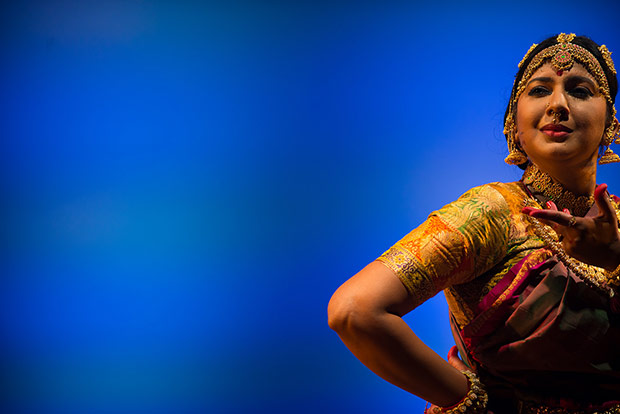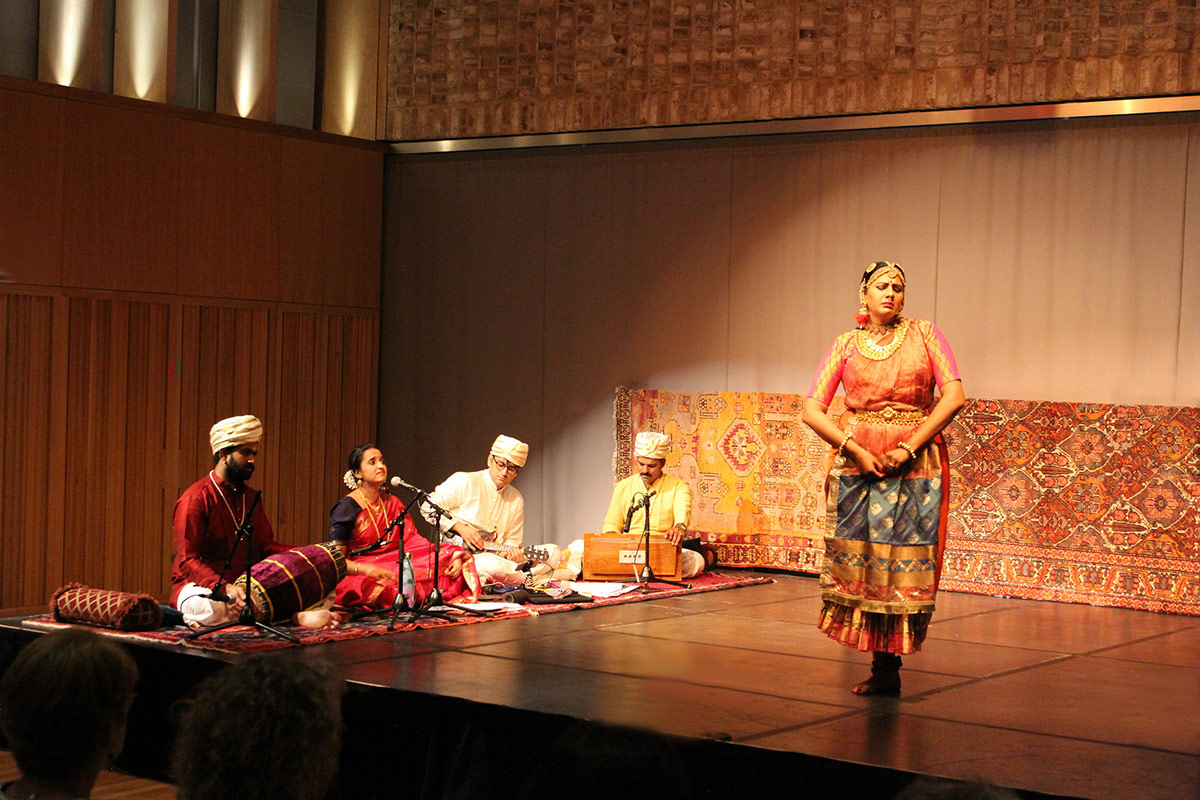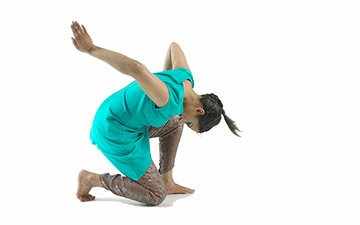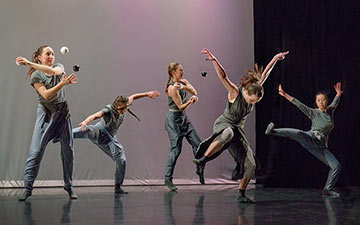
© Courtesy Dr Swarnamalya Ganesh. (Click image for larger version)
Akademi, Sama Art and Dr Swarnamalya Ganesh
Sadir Āttam: Dancing for Rajahs, Nawabs and the Officers of the Raj
★★★★✰
Cambridge, Storey’s Field Centre
28 June 2019
swarnamalya.wixsite.com/website
akademi.co.uk
sama.co.uk
www.storeysfieldcentre.org.uk
Sadir dance is a controversial precursor to Bharatanatyam, the classical dance style of South Asia. Sadir is a genre fraught with social and political complications and implications. Banned for 150 years, it is only now being reinstated by researchers and performers who value its tradition and the women who made it their profession.
Two performances, in Cambridge and London (at LSO ST Luke’s), were by Dr Swarnamalya Ganesh, a Bharatanatyam dancer, academic, actress and TV anchor in India. She learnt the five dances she showed us from elderly devadasi performers who kept the Sadir repertoire alive during years of repression. The dances involve improvisation, so the choreography is not fixed: nor is it as formalised as Bharatanatyam, which has subsumed the Sadir genre.
The issue concerning the Sadir performers in the 18th to early 20th centuries is that they were secular entertainers, not temple maidens (or bayadères). They were courtesans, who performed for the courts of rajahs and nawabs, and for officers of the British Raj. Like Japanese geishas, they were skilled at entertaining rich and powerful men, and they were well versed in courtly etiquette. As professional single women without husbands, they were entitled to pass on their assets through the female line.
This was resented by patriarchal Indian society, ready to support Victorian British rulers in banning the licentious female performing caste. Missionaries disapproved of the sensual dancers, as did British governors and military officials. Sadir dance, thanks to its derogatory reputation, went underground, despised by more privileged practitioners, who later codified Bharatanatyam as a respectable form of classical South Asian dance. Like ballet, Bharatanatyam became a graceful technique that every young girl should learn, without necessarily intending to become a professional practitioner.

© Nina Head. (Click image for larger version)
Dr Ganesh’s programme of Sadir dances across three centuries was part of a festival of South Asian dance in a new community centre to the north west of Cambridge. Storey’s Field Centre’s performance hall is stunning, crafted in wood panelling, with a lovely studio nearby, giving onto a garden. The building complex won architectural awards last year https://www.storeysfieldcentre.org.uk/about/facilities
Dr Ganesh was accompanied by three Indian musicians and a versatile singer, Sangeetha Sudhir. As well as a hand drum, the instruments included a mandolin and harmonium that are no longer used for Bharatanatyam concerts. She introduced each dance, setting them in their historical context and mentioning the different languages used in the lyrics of the songs. Because the Indian potentates were interested in a variety of cultures, their entertainers assimilated influences from Persian, Arabic and Muslim literary and musical traditions. Court composers even incorporated English and celtic airs – and a Sanskrit version of the British national anthem.
The programme started and ended with two very different salutations, or salaams. The first was an 18th century welcome for the Maratha King of Tanjore in Tamil Nadu. The singer recited the genealogy and titles of Serfoji II, extolling his virtues as a ruler, while Dr Ganesh repeatedly curved her right arm towards her face, as she came forward and retreated, stamping rhythmically. The footwork in Sadir dances appears simpler than the complex technique developed for Bharatanatyam performances. The salaam was respectful, less overtly alluring than the dancer’s demeanour later in the concert.
The final salutation was intended for a courtly reception for British rulers in the early 20th century. Instead of a praise song for a maharaja, God Save the King was woven into the music, which included military band marches and catchy European folk tunes. This time, Dr Ganesh saluted mockingly as she paraded back and forth, right hand held stiffly to her forehead. Everyone in the audience was tapping along to her footwork, ankle bells jingling, enjoying the merging of very different popular cultures.
In between came flirtatious dances with stories to tell. The emphasis was on expressive mime, nritya, rather than pure dance. A 19th century Pada Varnam performance had the dancer inviting the deity of Tanjore to make love to her. ‘Enough of the flirting’, say the lyrics, ‘I am dizzy with desire, fondle my breasts, kiss me…’ The gestures were specific, with a hand raised provocatively to fend off imagined advances.
A rather more spiritual Sufi poem from the 18th century evoked a maiden in distress, imploring an incomprehensible god to reside in her heart rather than in a sacred temple. Dr Ganesh was seated, sweeping her arms around her before touching her heart, then rising to dance in dignified supplication.
Then she became a good-time girl, titillating officers of the Raj at a banquet. The javali song, with an English refrain, ‘Oh my lovely Lalana’, was alledgedly composed for General Pigot, bachelor governor of Madras in 1755. (The song has since been used in a Bollywood movie and music album.) Dr Ganesh teased and pouted as Lalana and strutted lasciviously as her would-be suitor.
She took on both roles for a 19th century Gujili javali, a popular piece about another naughty girl cajoling an admirer to come inside her house. Reluctant to be seen entering, he hesitates, she mocks him, he succumbs, and she steals his money. Like Giselle’s mother’s mime, the meaning of the gestures, timed to the music, is perfectly clear once the convention is familiar.
The Sadir genre is charming, very feminine and without pretensions to be anything other than entertainment, albeit designed for a male gaze. It was fascinating to see it brought to life again – rather like watching Alexei Ratmansky’s reconstructions of 19th century ballets with the original mimed passages and a less virtuoso technique than in modern productions. I am no expert in South Asian dance forms and traditions, nor in Indian social politics, so I simply enjoyed the performance, enchanted by the skills of Dr Ganesh, Sangeetha Sudhir, the singer, and the musicians, Guru Bharadwaaj, Srikrishnan Balasubramanian and Balaji.












You must be logged in to post a comment.